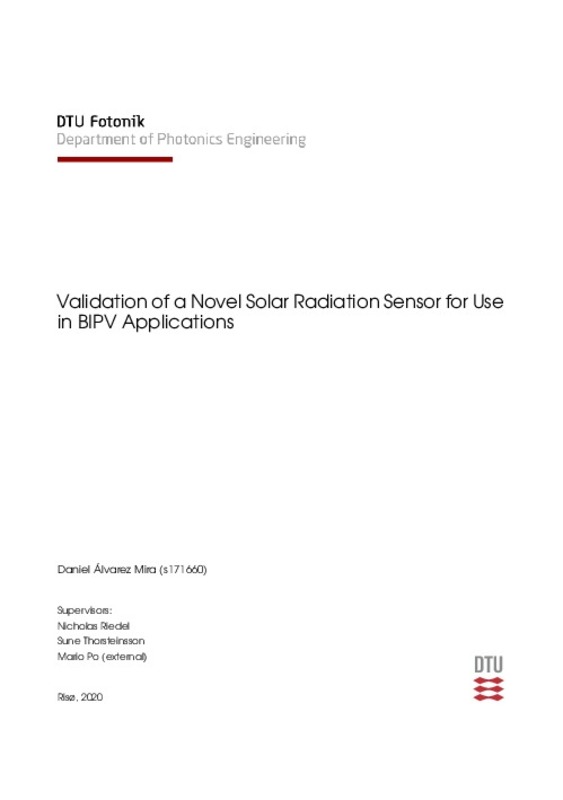|
Resumen:
|
[EN] The solar radiation assessment is a key factor for this growth as it is the critical variable for all solar energy generation systems. EKO instruments has developed a sensor
that integrates six photodiodes to measure ...[+]
[EN] The solar radiation assessment is a key factor for this growth as it is the critical variable for all solar energy generation systems. EKO instruments has developed a sensor
that integrates six photodiodes to measure solar irradiance upwards (global horizontal), downwards (ground reflected) and irradiance in all four cardinal directions for
vertical surfaces. It is believed that the extra data would reduce uncertainty in prediction of PV outputs during the design phase and performance verification during
the PV plant operation. This could therefore enhance the investment in vertical PV
systems such as BIPV or east-west BF plants.
In the first place, an investigation on the optimal transposition model for BIPV
facades with GHI as the only input was carried out. A decomposition model fitted for
the studied region was created. Two different study cases were conducted with the
intention of identifying the optimal transposition model among the five studied and
to account for the inaccuracies that the new decomposition model might introduced
to the process. The results validated the use of the new decomposition model for
south facing surfaces. Nevertheless, its use for non south-facing surfaces did not show
the same accuracy, which was increased when the uncertainties of the GHI sensor
were taken into account. None of the anisotropic studied models can be declared
as the best performing, nor does any particular model demonstrate clear advantages
over the others for the location and scenarios studied here.
The measurements from the vertical sensors in the MDPD within a five month
period were compared to the transposed irradiance from a PD installed nearby. The
inherent errors that project developers of vertical PV systems should account for in
the choice between the use of measured (MDPD) or transposed data (and the associated transposition model choice) were accurately quantified. For north facing
surfaces, the average error of each predicted irradiance value over the measured one
(RMSE) can be up to 11.2 W/m2
, overestimating the solar irradiance by 6 W/m2
should they choose to not use measured data, or the optimal transposition model. In
the case of a south-facing surface those errors can be up to 45.5 W/m2 and 12.8 W/m2
respectively. The east and west facing surfaces could show RMSE of 26.5 W/m2 and
24.2 W/m2
, and MBE of -4.5 W/m2 and 4.6 W/m2
respectively
[-]
[ES] En este proyecto, el alumno trabajará con mediciones tomadas por un sensor de fotodiodo multidireccional (MDPD) desarrollado por EKO Instruments. El MDPD consta de seis fotodiodos de silicio independientes que pueden ...[+]
[ES] En este proyecto, el alumno trabajará con mediciones tomadas por un sensor de fotodiodo multidireccional (MDPD) desarrollado por EKO Instruments. El MDPD consta de seis fotodiodos de silicio independientes que pueden enfrentar las cuatro direcciones cardinales (N-E-S-W), hacia arriba (horizontal global) y hacia abajo (reflejada del suelo). Las posibles aplicaciones fotovoltaicas (PV) para este sensor incluyen la construcción de sistemas fotovoltaicos integrados en edificios (BIPV) donde los paneles PV a menudo se montan verticalmente y en superficies no orientadas al sur y fotovoltaica bifacial (FV BF) donde la radiación reflejada del suelo (albedo) es de gran interés. La mayoría de las estaciones meteorológicas y las bases de datos solo proporcionan datos de irradiación horizontal global (GHI), por lo que el objetivo de este proyecto es demostrar los beneficios de los datos adicionales de un MDPD. Este proyecto es una colaboración entre DTU Fotonik y EKO Instruments B.V. para validar el sensor MDPD. El estudiante puede esperar trabajar en estrecha colaboración con estos dos socios.
El sensor MDPD se instalará próximo a los sensores de radiación solar de Clase A de DTU Fotonik, que se utilizarán para la validación del MDPD. Durante el proyecto, el alumno se familiarizará con las diferencias inherentes entre los sensores de Clase A y MDPD, varios modelos de transposición y modelos de rendimiento BIPV.
Objetivos:
- Identificar el modelo de transposición óptimo (por ejemplo, Pérez, Reindl, Hay & Davies, etc.) para estimar la irradiación en fachadas BIPV utilizando solo irradiación global en el plano horizontal.
- Utilizar los datos del MDPD para estimar la producción solar en un sistema BIPV en Dinamarca.
- Estimar el error sistemático al que se arriesgan los desarrolladores de proyectos BIPV si no utilizan el modelo de transposición apropiado, o si no usan el MDPD para su evaluación de los recursos solares.
[-]
|







